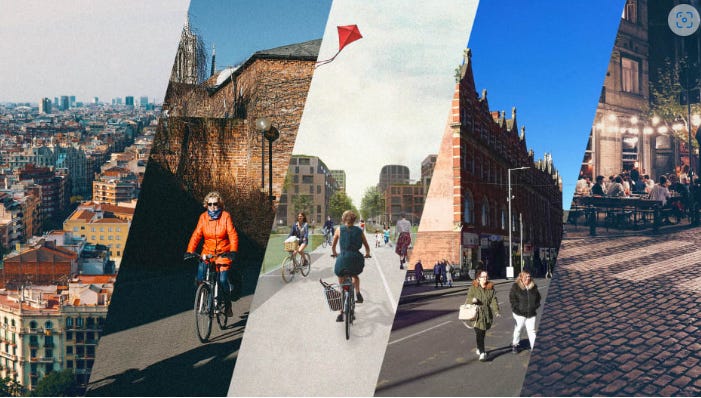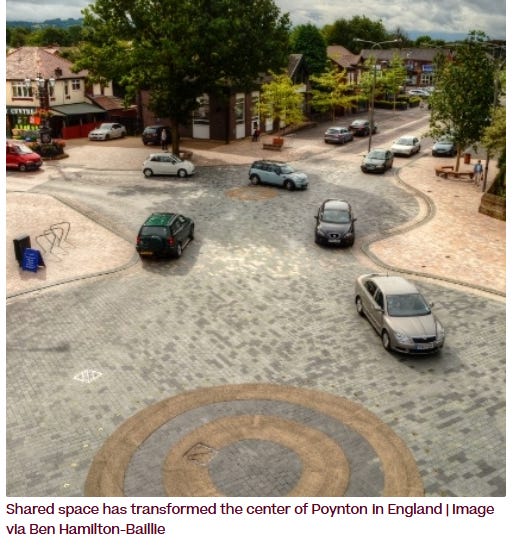Shared spaces and the 'war on the motorist' | Issues around 're-sharing' the street
It is ironic that despite allocating emergency funding during the pandemic for widening pavements, providing additional cycle lanes, and making available modest resources for improved public transport and cycling infrastructure, the delivery of net-zero policies in towns and cities has emerged as a strong dividing line between political parties in the current general election in the UK.
Many of the schemes originally intended to provide more spaces for people and to facilitate mobility at a time of enforced local living are now seen by some as part of an alleged ‘war on the motorist’. Along with traffic calming measures such as slower speed limits, low traffic neighbourhoods and ultra-low emission zones, moves to re-allocate road space are deemed to be curtailing people’s freedom over transport and an attack on the day-to-day lives of the majority of people. As Prime Minister Sunak declared it is time to ‘support the motorists who keep the country moving’. It seems that the thinking behind the pandemic-based moves to re-allocate street spaces towards people and places has so far failed to achieve the general acceptance of the idea of streets as shared spaces able to reconcile the interests of people, place and traffic.

Streets as shared space
Streets typically represent the largest area of public space a town or city has. And as cities usually require a high level of urban mobility to enable people to move around to reach city facilities and places of work and businesses to access goods and services, it is perhaps not surprising that mobility has typically dominated discussions of street design for many years. The idea of streets as a shared space is commonly approached through traffic engineering and traffic calming, a design approach aimed at reducing the dominance of motor vehicles through reducing speed and other measures to encourage drivers to be more accommodating to pedestrians and other street users.
Over recent decades this approach has led to increasing segregation of street users into traffic lanes and parking spaces for vehicles and sidewalks for pedestrians accessing shops, street cafes and other facilities. Designated crossing points allow people to move from one side of the street to the other. Segregation in recent years has been complicated by the addition of bus lanes for public transport and cycle ways for active travel.
Prioritizing mobility in these ways suggests a conception of the street as a space for getting into and through a city, and runs the risk that in trying to accommodate traffic, streets become so heavily dominated by vehicles that they lose their primary purpose as spaces to attract people and encourage and support investment in business and recreational and cultural facilities. In short the approach to shared streets through traffic engineering forgets that streets are, or should be multi-purpose places designed to give equal prominence to each of these purposes.
Street design should ensure that the interests of all users are recognized and accommodated. Such an approach emphasizes the social and community aspects of shared space. Design should be focused not only on the interaction between different street users, but also on those living and working there. Shared space in this sense almost inevitably means de-prioritizing motor vehicles and removing, or at the least reducing, their user priority. The tensions which have now become apparent locally, and which have been picked up politically, demonstrate the difficulties which arise in winning acceptance for these priority shifts.
Designing ‘sharedness’
The degree of ‘sharedness’ achieved in street design varies widely. At one end of the spectrum are shared space designs which largely de-segregate road users through removing traffic lights and other traffic controls and most road markings and signage. Usually these will be found in low-speed areas which allow users to move safely around the space based on social cues rather than a designated right of way to one user group or another. Pioneered by Dutch traffic engineer Hans Moderman who advocated the removal of signage and traffic controls so that road users have to ‘negotiate’ traffic movement and the use of public street space. Local experiments produced dramatic results, and demonstrated the ability of this approach to reduce traffic incidents and allow communities to regain public space for shops, bars and the like.

Such schemes have been applied to the development of some new residential areas with the purpose of providing shared spaces which encourage social interaction, safe play and sustainable environments. Clearly the transferability of this concept to already established areas is challenging, but the thinking behind the provision of low traffic neighbourhoods within residential zones in towns and cities is similar, even if the extent of ‘sharedness’ is significantly less. Nevertheless, these schemes do reduce the ‘right to the road’ for the motor vehicle. The aim is to create spaces in which cars are ‘guests’ and not masters of the public realm.
Put in these terms, improving the ‘sharedness’ of street and street design invites a reaction from those users who see their traditional and assumed dominance of street space to be threatened. The threat has become politicized as a ‘culture war’ and a ‘war on motorists’.
Changing the culture
The challenge to overcome these perceptions is considerable. Culture change requires understanding of relevant research into the consequences of vehicle dominating street space. There is increasingly strong evidence of the benefits to health, to safety, to the environment and to well-being and the quality of life from reducing the priority given to the car in the organization of street space, but it is not helpful to those feeling threatened to be presented with bald facts like these:
- Cars waste a lot of space: the street space allocated to cars, moving and stationery, is In most cases much larger than the space provided for other street users.
- Cars waste a lot of energy. Even electric vehicles use a lot of energy which could be saved if more use was made of bikes, feet and public transport.
- Cars pollute
- Cars kill people
- Car-free places are much more attractive.
- Freed-up car spaces like car parks could be allocated to alternative uses such as housing, businesses, green spaces and parks and other features that add to the quality of a place.
Whilst evidence can be found to support each of these assertions, clearly such evidence is not always accepted and may be denied. More account must be taken of other factors such as personal values and emotions which can undermine moves towards culture change around the (re)allocation of street space.
The extent to which streets might be shared can, for example, become a clash between someone who values the importance of clean air and another who feels any health benefits do not outweigh the costs to those who may no longer be able to drive along a street. Emotions too can bias reasoning to the extent that individuals may be a committed environmentalist, but still continue with the convenience driving.
These sources of disagreement are often conflated. With modern digital communications and social media, arguments based on values and emotions can become more prominent than those relying on the rational evidence-base.
Short- and long-term change
Disagreements based on values and emotions can be hard to resolve, especially in the short term and in a charged political context. The reality is however, that the current model of private car ownership used for a large proportion of journeys is not sustainable in the longer term. Transport behaviors are bound to change over the coming years, just as they have evolved over past decades as we transitioned from the horse and carriage to motor vehicles in the light of technological, economic and social change. Our concern should be not about whether change will come but how and how fast.
Transport transitions will be the result of interactions between people with passions, challenges and choices to make. We need to understand these, and rather than look back to preserving what is, look for ways to support change going forward. In the UK we probably under-estimate the how deeply people cherish the car in modern culture even when motorways and city streets are severely congested. Rather than a war on motorists, there should be a focus on enhancing the life of all street users including the motorist.
The socio-economic context
Whilst re-allocating street space can transform neighbourhoods, it has to be recognized that schemes impact different people in different ways, and some groups more than others. Car ownership is not universal. Accessibility of public transport varies widely from location to location. Not everyone is able to adopt active travel. We need to understand what people in different socio-economic groups are using streets for. For some it is to meet the needs of local living. For others, streets are a means to get somewhere else. We need to understand the options people have and the basis for the choices they make. We need evidence for culture change to ask much more subtle questions around these issues of place, rather than the bald statistical data highlighted above.
Streets which have been ‘re-shared’ need to be seen to be about cleaner air, healthier environments and enhanced attractiveness without disproportionately impacting or excluding particular groups. There are a growing number of schemes which are demonstrating what can be achieved in this regard. Evidence suggests that even motorists have come to appreciate the benefits of car-free city-centres and low car residential areas.
So we need to let culture change happen. Lived experience is beginning to show that too many cars are self-evidently inhibiting city life, not because of pollution but also because of the limitations they pose for other activities people and visitors want to pursue to gain the benefits of city living. When cars move out, people move in and do things like setting up markets, having conversations, eating out, playing sport, making art, or appreciating city heritage.
We don’t need to demonize the motorist. Changes in values and emotions towards re-sharing streets need to be ‘nudged’ by urban planners through deeper conversations with communities, communicating experience with already successful schemes to all street user groups, and backed by more relevant data which addresses the socio-economic impact of re-sharing street space both for those who live around about and those passing through.
Re-sharing street space in this way offers a holistic recreation of streets as places. Increasingly smart technologies are being used to provide innovative ways of using streets, but it also requires a collective will to embrace change.
Source: Substack
 Printer-friendly version
Printer-friendly version- Login to post comments







